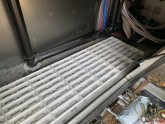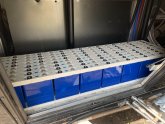i keep reading about the Structural Worry about these blue aluminum cells - for mobile use -is this really an issue?
i once drove my class C from inside Sebring Raceway over their bridge, thru dirt, grass, gravel and uneven concrete over 1hr home leaving a bottle of water 80% filled on my countertop without it even spilling or falling over (all done accidentally).
So i dont know who's doing the Baja1000 with their RV's but i just don't see this "Structural Worry" being a big thing....
?
Depends on your use case. I'm not familiar with the Sebring raceway, but I've had battery trays fail on washboard, had battery posts down from friction to the point couldn't hold securely, had a rear spare tire holder bolts vibrate loose, had my passenger window assembly fail, had trim pieces rattle off, and came across a big beefy custom 4x4 class C RV left on the side of a remote death valley road because the wheel studs had all sheered off and it lost a wheel in the middle of nowhere. But short of sheering off your wheel studs, bad washboard will rattle your teeth, stress every screw and fastener, shake loose anything that can shake loose, open drawers and cupboards, and wear through paint and finish anywhere there is a little friction. 5 minutes on washboard probably won't cause anything to fail, 5 hours probably won't either, but if you plan to do a lot of exploring off the beaten path, its something you've got to account for. 90-95% of people will not put themselves in enough situations to spend a lot of time worrying about this type of thing, but for the people that do, it definitely needs to be designed for. But there are probably a lot of other things on your class C that would fail before the batteries would (including possibly the class C itself), so its probably not something to worry about in your case.
Washboards are a bitch, potholes, and rough rocky tracks are no better. off camber situations can also introduce a ton of torsional stress on the vehicles frame and body (not an issue for your batteries, definitely an issue for your RV body--see:
the chassis flex in this picture). True overland vehicles are designed to account for this torsion and isolate the body from the frame allowing the frame to twist without transferring those forces to the body of the vehicle, or by strengthening the frame to the point it does not flex and will not fail due to not flexing. In the picture above the camper body is isolated from the frame, that is why you body and the cab are at such extremely different angles. If this were not the case, all that stress would be transferred to the much weaker walls and frame of the camper.
In terms of batteries, two biggest risks I see mechanically would be (1) wear or damage to the sidewalls from long term friction and vibration over months or years, or (2) damage to the internal structure of the battery resulting from shocks and/or friction over time. The marine folks recommend smaller Ah cells <200ah and <=100ah as a best practice due to the potential for larger cells to fail internally due to the repeated shock from waves/water hitting the hull which can be quite jarring.
So in reply to your statement that:
So i dont know who's doing the Baja1000 with their RV's but i just don't see this "Structural Worry" being a big thing....
I think it depends, for you its probably not a worry, and for anyone that doesn't push the limits of a class C, its probably not a worry. But a blanket assumption that '"structural worry" isn't a big thing' is misguided, in my opinion. It just depends what you are designing for, and how harsh an environment you expect to operate in (and what the consequences of failure in your situation are). Probably a good rule of thumb is
if you aren't designing/selecting your whole vehicle around operating in harsh conditions, don't bother worrying about battery ruggedness, but if you are, you should worry about the ruggedness of your electrical system and batteries as well.
As for blue cells, I have no idea if they are or aren't up to the task (hence starting this thread), or if some simple modifications like putting a few mm of rigid plastic between the cells, or using some sort of friction pads, or maybe just double sided vhb tape, would mitigate any issues. But I would like to know more and learn from other peoples experiences. Maybe its not worth losing any sleep over, but I tend to overthink and overdesign, and I tend to use my vehicles pretty rough, and go to places where safety and self reliance are pretty important, and I'm pretty tame when it comes to overlanding compared with others.





